外研版(2019)高中英语必修第一册Unit 6 At one with nature Understanding ideas 名师课件(32张)
文档属性
| 名称 | 外研版(2019)高中英语必修第一册Unit 6 At one with nature Understanding ideas 名师课件(32张) | 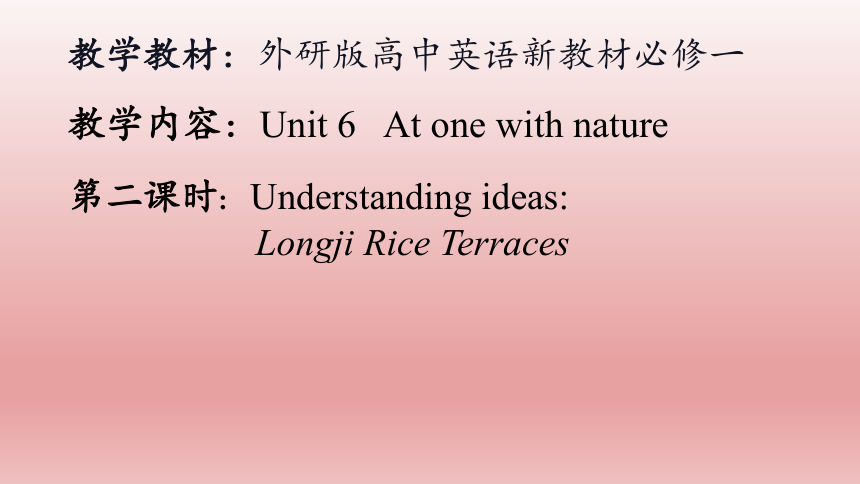 | |
| 格式 | pptx | ||
| 文件大小 | 16.1MB | ||
| 资源类型 | 教案 | ||
| 版本资源 | 外研版(2019) | ||
| 科目 | 英语 | ||
| 更新时间 | 2023-02-26 13:50:50 | ||
图片预览



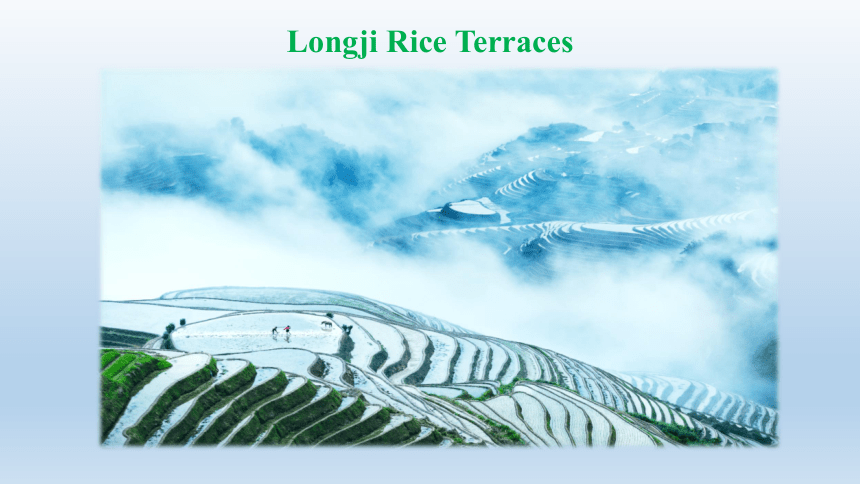
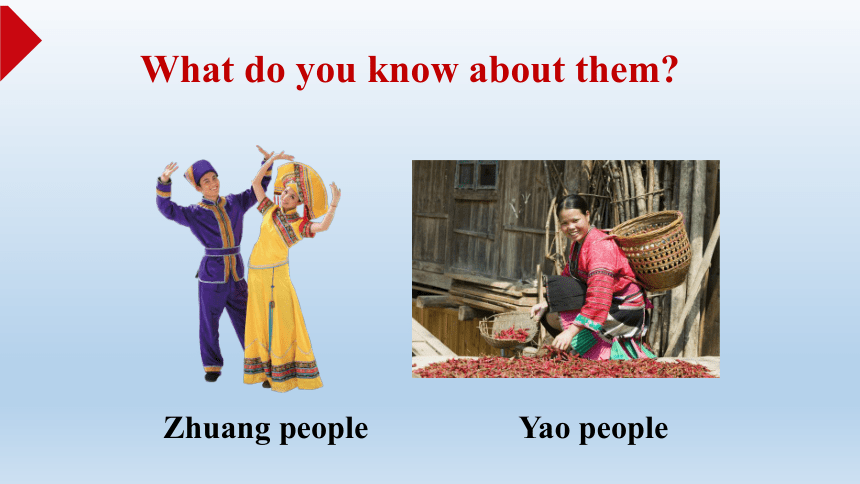
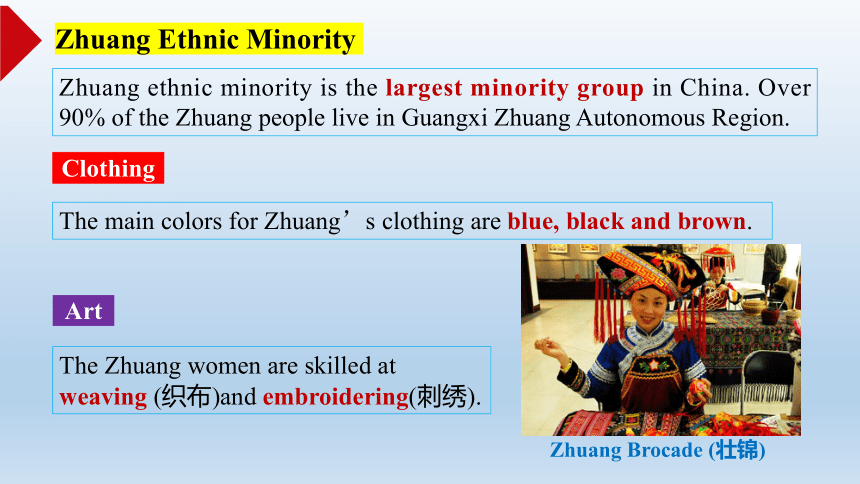
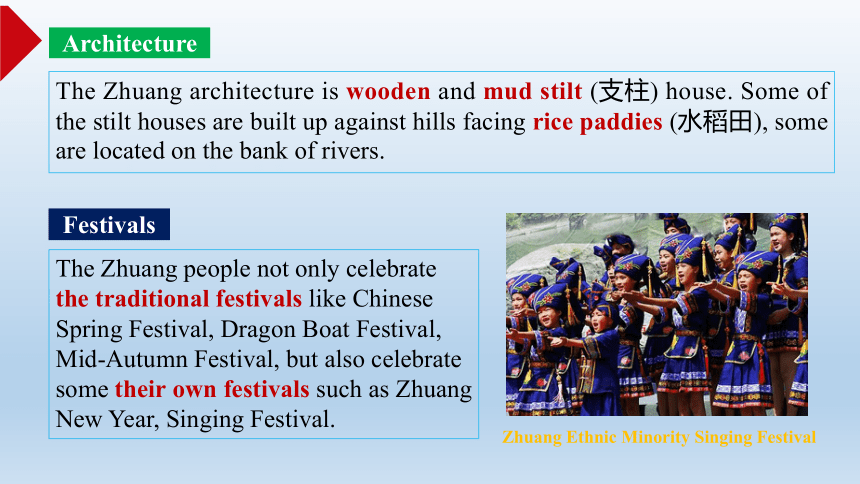
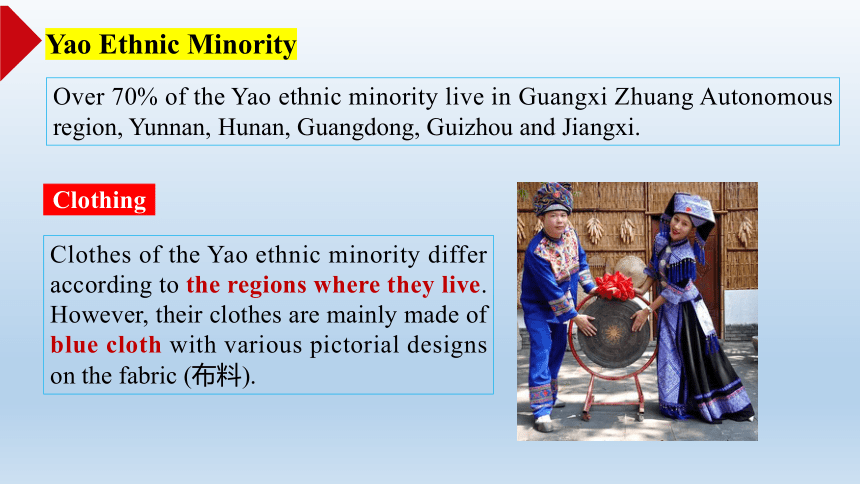
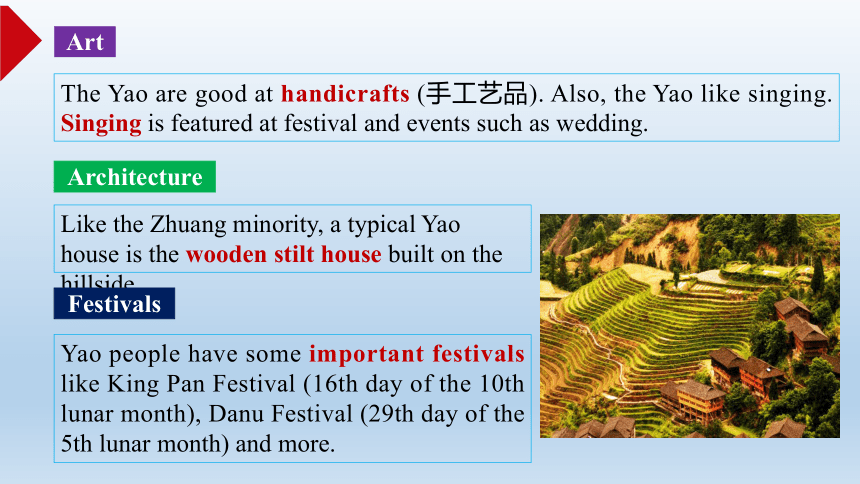
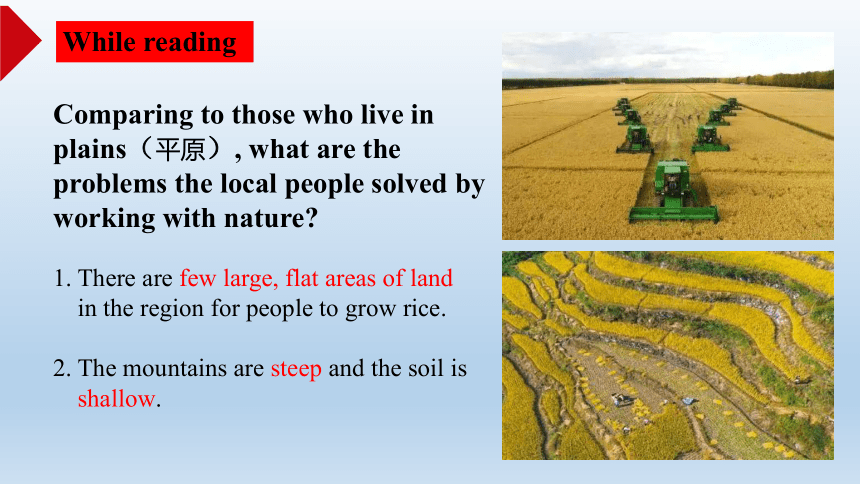
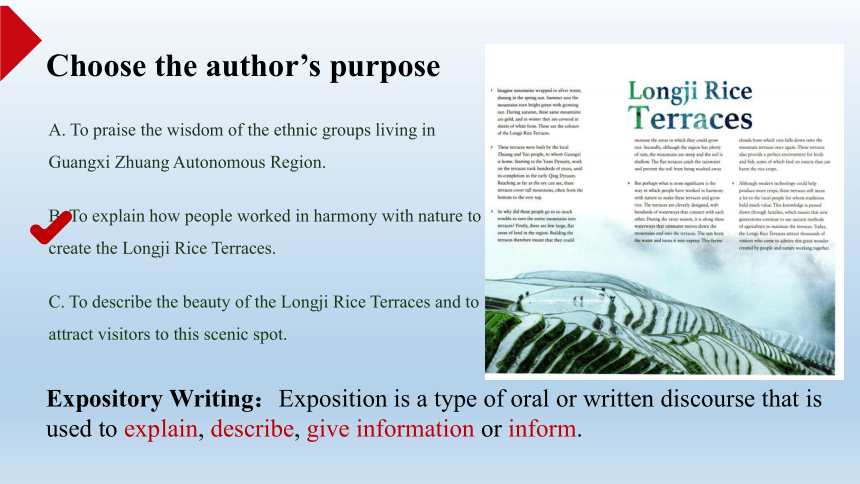
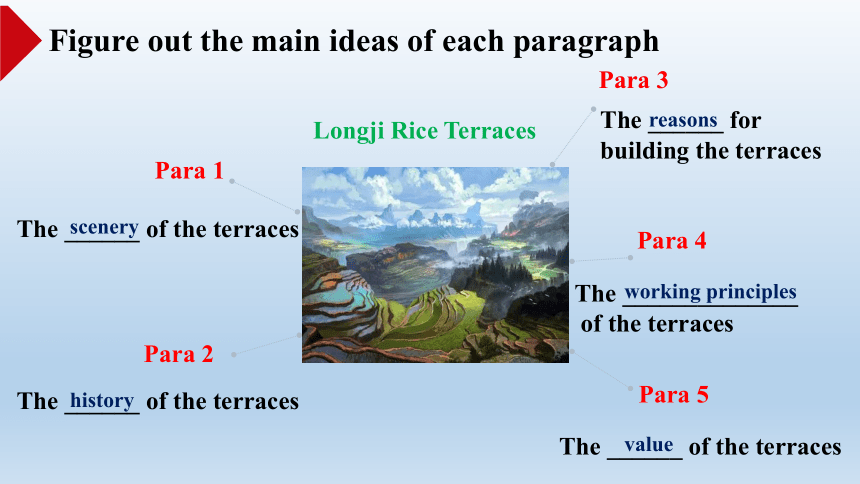
文档简介
(共32张PPT)
教学教材:外研版高中英语新教材必修一
教学内容:Unit 6 At one with nature
第二课时: Understanding ideas:
Longji Rice Terraces
Lesson 1
Starting out & vocabulary
威尼斯环境问题及解决方法,自然对人的影响
Lesson 2
Reading
中国龙脊梯田开垦原因及运作原理
Lesson 3
Using language
天然染料
Lesson 4
Speaking& listening
地貌特征,不同气候区的人类生活
Lesson 5
Reading
英国人对园艺的热爱
Lesson 6
Writing
英国果茶草茶文化的概要写作
Lesson 7
Presenting& reflection
自选理想居住地,展示
课时设计与衔接
深入理解人与自然的相关性,辩证看待问题,树立人与自然和谐共处的意识。
大观念:通过了解和思考不同自然环境对人类生活的影响,从而理解人与自然的关系,培养共情能力,提升人与自然和谐共处的意识
不同地貌和气候对人类生活方式的影响
人类对自然的合理运用和改造
引导学生联系实际,讲述环境对自己生活的影响,为整个单元做铺垫
At one with nature
Before reading
What is your understanding of “at one with”
In a peaceful state as a part of something else.
Who should be at one with nature
What’s the meaning of this title
People should be at one with nature.
Longji Rice Terraces
Zhuang people
Yao people
What do you know about them
Zhuang Ethnic Minority
Zhuang ethnic minority is the largest minority group in China. Over 90% of the Zhuang people live in Guangxi Zhuang Autonomous Region.
The main colors for Zhuang’s clothing are blue, black and brown.
The Zhuang women are skilled at weaving (织布)and embroidering(刺绣).
Clothing
Art
Zhuang Brocade (壮锦)
The Zhuang architecture is wooden and mud stilt (支柱) house. Some of the stilt houses are built up against hills facing rice paddies (水稻田), some are located on the bank of rivers.
The Zhuang people not only celebrate the traditional festivals like Chinese Spring Festival, Dragon Boat Festival, Mid-Autumn Festival, but also celebrate some their own festivals such as Zhuang New Year, Singing Festival.
Zhuang Ethnic Minority Singing Festival
Festivals
Architecture
Yao Ethnic Minority
Over 70% of the Yao ethnic minority live in Guangxi Zhuang Autonomous region, Yunnan, Hunan, Guangdong, Guizhou and Jiangxi.
Clothes of the Yao ethnic minority differ according to the regions where they live. However, their clothes are mainly made of blue cloth with various pictorial designs on the fabric (布料).
Clothing
The Yao are good at handicrafts (手工艺品). Also, the Yao like singing. Singing is featured at festival and events such as wedding.
Like the Zhuang minority, a typical Yao house is the wooden stilt house built on the hillside.
Yao people have some important festivals like King Pan Festival (16th day of the 10th lunar month), Danu Festival (29th day of the 5th lunar month) and more.
Art
Architecture
Festivals
Comparing to those who live in plains(平原), what are the problems the local people solved by working with nature
There are few large, flat areas of land in the region for people to grow rice.
The mountains are steep and the soil is shallow.
While reading
Choose the author’s purpose
A. To praise the wisdom of the ethnic groups living in Guangxi Zhuang Autonomous Region.
B. To explain how people worked in harmony with nature to create the Longji Rice Terraces.
C. To describe the beauty of the Longji Rice Terraces and to attract visitors to this scenic spot.
Expository Writing:Exposition is a type of oral or written discourse that is used to explain, describe, give information or inform.
Figure out the main ideas of each paragraph
Para 3
The ______ of the terraces
Para 2
The ______ of the terraces
Para 1
Para 5
Para 4
The ______ for building the terraces
The ______________
of the terraces
The ______ of the terraces
history
working principles
reasons
value
scenery
Longji Rice Terraces
The Longji Rice Terraces were built by the local Zhuang ethnic group alone. Though there are many large, flat areas in the region, they built terraces on the mountains to have more areas to grow rice. The terraces are cleverly designed, and can wash away the shallow soil. There are hundreds of waterways, along which rainwater moves down the mountains and into the terraces. Today, local people use modern methods to maintain the terraces, and they attract lots of visitors from all over the country.
by the local
Zhuang and Yao people
Since
few large
hold
ancient methods of
agriculture
flat areas of land in the region
Read the summary of the passage and correct the factual mistakes.
A good summary covers the “5W1H” aspects. Find which paragraph they are in.
Who
When
Where
What
How
Why
Structure
Para 1
Para 2
Para 3
Para 4
Para 5
What
Learn to summarize
wrapped in _____ water
Bright _____
_____
Covered in sheets of_____ frost
silver
green
gold
white
Who
When
Where
Zhuang and Yao people
Guangxi Province
Started in Yuan Dynasty,
completion in the early Qing Dynasty
3. So why did these people go to so much trouble to turn the entire mountains into terraces Firstly, there are few large, flat areas of land in the region. Building the terraces therefore meant that they could increase the areas in which they could grow rice. Secondly, although the region has plenty of rain, the mountains are steep and the soil is shallow. The flat terraces catch the rainwater and prevent the soil from being washed away.
Terraces mean a lot
Traditions hold much value
New generations continue to use ancient methods
Positive
It still means a lot and new generations continue to use.
A great wonder created by people and nature working together.
What
What
Who, Where, When
Why
How
Longji Rice Terraces
Different colors in different seasons
Who: Zhuang and Yao people
Where:
Guangxi
When: in the Yuan Dynasty
1 few large, flat areas of land
2 steep mountains and shallow soil
Working principle:
rainwater-waterways-vapour-clouds-rainwater…
Learn to retell
A sample for retelling
The Longji Rice Terraces is worth a visit year-round. It turns silver in spring, green in summer, gold in autumn and white in winter. Located in Guangxi Province, the terraces were built by the local Zhuang and Yao people. Starting from Yuan Dynasty, the work on them was finally completed in the early Qing Dynasty.
For a lack of large flat areas of land, steep mountains and shallow soil, the locals built the terraces, which are cleverly designed and can hold soil, to have more areas to grow rice. There are hundreds of waterways, along which during the rainy season rainwater moves down the mountains and into the terraces. The sun heats the water and turns it into vapour. This forms clouds from which rain falls down onto the mountain terraces once again.
Today, local people still use the ancient methods to maintain the terraces, which are a great wonder created by people and nature working together, attracting countless visitors.
Why do the local people still keep their traditional way of growing rice
In what other ways do people live in harmony with nature Give examples.
The knowledge and wisdom are passed down through generations of families, and it suits the natural environment.
Post reading
Think & Share
坎儿井
窑洞
傣家竹楼
An irrigation (灌溉) system of wells connected by underground channel used in Xinjiang
Cave dwellings in north-west China
Bamboo house of Dai people
Over 2,200 years ago, Chengdu in China was threatened by the frequent floods caused by flooding of the Minjiang River (a tributary of the Yangtze River). Li Bing, a local official of Sichuan Province at that time, together with his son, decided to construct an irrigation system on the Minjiang River to prevent flooding. After a lengthy study and a lot of hard work by the local people, the great Dujiangyan Irrigation System was completed. Since then, the Chengdu Plain has been free of flooding and the people have been living peacefully and affluently.
Dujiangyan Irrigation System is honored as the ‘Treasure of Sichuan’, which still plays a crucial role in draining off floodwater, irrigating farms and providing water resources for more than 50 cities in the province.
Further Reading
Dujiangyan is the oldest and only surviving no-dam irrigation system in the world and a wonder in the development of Chinese science. The project consists of three important parts, namely Yuzui, Feishayan and Baopingkou scientifically designed to automatically control the water flow of the rivers from the mountains to the plains throughout the year.
Flying-Sand Weir (Feishayan)
Bottle-Neck Channel (Baopingkou)
Fish Mouth Levee (Yuzui)
Yuzui, like a big fish lying in the Minjiang River, is a watershed dividing the river into two parts: inner river and outside river. Feisha Yan is a spillway that diverts the sand and stones of the inner river into the outer river. Baoping Kou, like a neck of a bottle, is used to bring water into the inner river from Minjiang. At the same time, Baoping Kou controls the amount of the intake water due to its reasonable location. These three parts interact with each other perfectly to form an effective water conservancy project. During the low-water season, 60% of the Minjiang water is brought into the inner river for irrigation while 40% of the water is drawn into the outside river. The situation is reversed in the flood season ensuring the water supply for irrigation and protection from flooding on the Chengdu Plain.
Sentence Analyzing & Further Learning
1. Reaching as far as the eye can see, these terraces cover tall mountains, often from the bottom to the very top.
V-ing短语做状语
eg.①Turning to the left, you will find the school.
向左拐,你就会发现那所学校。
②Knowing where I live, he never comes to see me.
尽管知道我住哪儿,但他从不来看我。
as far as
①As far as the eye can see, the waves are to be seen rolling in all directions.
目之所及,到处浪涛滚滚。
②As far as I know, compared with other countries, Chinese students spend much more time studying.
据我所知,与其他国家相比较,中国学生花费更多的时间来学习。
就……来说,在……范围内
做状语
Paraphrase
These terraces stretch all the way to the very far end of our vision, and often range from the bottom to the very top of tall mountains.
目之所及,梯田包裹着巍峨的高山,往往从山脚一直盘绕到山顶。
从山脚一直到山顶
2. During the rainy season, it is along these
waterways that rainwater moves down the
mountains and into the terraces.
it is
along these
waterways
that
主语
宾语
状语
强调人用
that/who,强
调物用that
It is/was
被强调部分
that/who+ 句子其余部分
+
+
eg.①It was Tom that/who broke the window.
就是汤姆打破了窗户。
②It is because he is ill that he can’t come.
正是因为他病了,所以他不能来。
在雨季,雨水会沿着这些水渠从山上流下进入梯田。
翻译句子
1. As far as I'm concerned, not only does outdoor exercise get us close to nature
but also give us relaxation from heavy schoolwork.
就我个人而言,户外运动不仅使我们接近大自然,而且使我们从沉重的学习任务中摆脱出来得以休息。
2. 他第一次遇见他的妻子是在公园里。
It was in the park that he met his wife for the first time.
Homework
Write a summary about Dujiangyan in no more than 150 words.
THANK YOU
教学教材:外研版高中英语新教材必修一
教学内容:Unit 6 At one with nature
第二课时: Understanding ideas:
Longji Rice Terraces
Lesson 1
Starting out & vocabulary
威尼斯环境问题及解决方法,自然对人的影响
Lesson 2
Reading
中国龙脊梯田开垦原因及运作原理
Lesson 3
Using language
天然染料
Lesson 4
Speaking& listening
地貌特征,不同气候区的人类生活
Lesson 5
Reading
英国人对园艺的热爱
Lesson 6
Writing
英国果茶草茶文化的概要写作
Lesson 7
Presenting& reflection
自选理想居住地,展示
课时设计与衔接
深入理解人与自然的相关性,辩证看待问题,树立人与自然和谐共处的意识。
大观念:通过了解和思考不同自然环境对人类生活的影响,从而理解人与自然的关系,培养共情能力,提升人与自然和谐共处的意识
不同地貌和气候对人类生活方式的影响
人类对自然的合理运用和改造
引导学生联系实际,讲述环境对自己生活的影响,为整个单元做铺垫
At one with nature
Before reading
What is your understanding of “at one with”
In a peaceful state as a part of something else.
Who should be at one with nature
What’s the meaning of this title
People should be at one with nature.
Longji Rice Terraces
Zhuang people
Yao people
What do you know about them
Zhuang Ethnic Minority
Zhuang ethnic minority is the largest minority group in China. Over 90% of the Zhuang people live in Guangxi Zhuang Autonomous Region.
The main colors for Zhuang’s clothing are blue, black and brown.
The Zhuang women are skilled at weaving (织布)and embroidering(刺绣).
Clothing
Art
Zhuang Brocade (壮锦)
The Zhuang architecture is wooden and mud stilt (支柱) house. Some of the stilt houses are built up against hills facing rice paddies (水稻田), some are located on the bank of rivers.
The Zhuang people not only celebrate the traditional festivals like Chinese Spring Festival, Dragon Boat Festival, Mid-Autumn Festival, but also celebrate some their own festivals such as Zhuang New Year, Singing Festival.
Zhuang Ethnic Minority Singing Festival
Festivals
Architecture
Yao Ethnic Minority
Over 70% of the Yao ethnic minority live in Guangxi Zhuang Autonomous region, Yunnan, Hunan, Guangdong, Guizhou and Jiangxi.
Clothes of the Yao ethnic minority differ according to the regions where they live. However, their clothes are mainly made of blue cloth with various pictorial designs on the fabric (布料).
Clothing
The Yao are good at handicrafts (手工艺品). Also, the Yao like singing. Singing is featured at festival and events such as wedding.
Like the Zhuang minority, a typical Yao house is the wooden stilt house built on the hillside.
Yao people have some important festivals like King Pan Festival (16th day of the 10th lunar month), Danu Festival (29th day of the 5th lunar month) and more.
Art
Architecture
Festivals
Comparing to those who live in plains(平原), what are the problems the local people solved by working with nature
There are few large, flat areas of land in the region for people to grow rice.
The mountains are steep and the soil is shallow.
While reading
Choose the author’s purpose
A. To praise the wisdom of the ethnic groups living in Guangxi Zhuang Autonomous Region.
B. To explain how people worked in harmony with nature to create the Longji Rice Terraces.
C. To describe the beauty of the Longji Rice Terraces and to attract visitors to this scenic spot.
Expository Writing:Exposition is a type of oral or written discourse that is used to explain, describe, give information or inform.
Figure out the main ideas of each paragraph
Para 3
The ______ of the terraces
Para 2
The ______ of the terraces
Para 1
Para 5
Para 4
The ______ for building the terraces
The ______________
of the terraces
The ______ of the terraces
history
working principles
reasons
value
scenery
Longji Rice Terraces
The Longji Rice Terraces were built by the local Zhuang ethnic group alone. Though there are many large, flat areas in the region, they built terraces on the mountains to have more areas to grow rice. The terraces are cleverly designed, and can wash away the shallow soil. There are hundreds of waterways, along which rainwater moves down the mountains and into the terraces. Today, local people use modern methods to maintain the terraces, and they attract lots of visitors from all over the country.
by the local
Zhuang and Yao people
Since
few large
hold
ancient methods of
agriculture
flat areas of land in the region
Read the summary of the passage and correct the factual mistakes.
A good summary covers the “5W1H” aspects. Find which paragraph they are in.
Who
When
Where
What
How
Why
Structure
Para 1
Para 2
Para 3
Para 4
Para 5
What
Learn to summarize
wrapped in _____ water
Bright _____
_____
Covered in sheets of_____ frost
silver
green
gold
white
Who
When
Where
Zhuang and Yao people
Guangxi Province
Started in Yuan Dynasty,
completion in the early Qing Dynasty
3. So why did these people go to so much trouble to turn the entire mountains into terraces Firstly, there are few large, flat areas of land in the region. Building the terraces therefore meant that they could increase the areas in which they could grow rice. Secondly, although the region has plenty of rain, the mountains are steep and the soil is shallow. The flat terraces catch the rainwater and prevent the soil from being washed away.
Terraces mean a lot
Traditions hold much value
New generations continue to use ancient methods
Positive
It still means a lot and new generations continue to use.
A great wonder created by people and nature working together.
What
What
Who, Where, When
Why
How
Longji Rice Terraces
Different colors in different seasons
Who: Zhuang and Yao people
Where:
Guangxi
When: in the Yuan Dynasty
1 few large, flat areas of land
2 steep mountains and shallow soil
Working principle:
rainwater-waterways-vapour-clouds-rainwater…
Learn to retell
A sample for retelling
The Longji Rice Terraces is worth a visit year-round. It turns silver in spring, green in summer, gold in autumn and white in winter. Located in Guangxi Province, the terraces were built by the local Zhuang and Yao people. Starting from Yuan Dynasty, the work on them was finally completed in the early Qing Dynasty.
For a lack of large flat areas of land, steep mountains and shallow soil, the locals built the terraces, which are cleverly designed and can hold soil, to have more areas to grow rice. There are hundreds of waterways, along which during the rainy season rainwater moves down the mountains and into the terraces. The sun heats the water and turns it into vapour. This forms clouds from which rain falls down onto the mountain terraces once again.
Today, local people still use the ancient methods to maintain the terraces, which are a great wonder created by people and nature working together, attracting countless visitors.
Why do the local people still keep their traditional way of growing rice
In what other ways do people live in harmony with nature Give examples.
The knowledge and wisdom are passed down through generations of families, and it suits the natural environment.
Post reading
Think & Share
坎儿井
窑洞
傣家竹楼
An irrigation (灌溉) system of wells connected by underground channel used in Xinjiang
Cave dwellings in north-west China
Bamboo house of Dai people
Over 2,200 years ago, Chengdu in China was threatened by the frequent floods caused by flooding of the Minjiang River (a tributary of the Yangtze River). Li Bing, a local official of Sichuan Province at that time, together with his son, decided to construct an irrigation system on the Minjiang River to prevent flooding. After a lengthy study and a lot of hard work by the local people, the great Dujiangyan Irrigation System was completed. Since then, the Chengdu Plain has been free of flooding and the people have been living peacefully and affluently.
Dujiangyan Irrigation System is honored as the ‘Treasure of Sichuan’, which still plays a crucial role in draining off floodwater, irrigating farms and providing water resources for more than 50 cities in the province.
Further Reading
Dujiangyan is the oldest and only surviving no-dam irrigation system in the world and a wonder in the development of Chinese science. The project consists of three important parts, namely Yuzui, Feishayan and Baopingkou scientifically designed to automatically control the water flow of the rivers from the mountains to the plains throughout the year.
Flying-Sand Weir (Feishayan)
Bottle-Neck Channel (Baopingkou)
Fish Mouth Levee (Yuzui)
Yuzui, like a big fish lying in the Minjiang River, is a watershed dividing the river into two parts: inner river and outside river. Feisha Yan is a spillway that diverts the sand and stones of the inner river into the outer river. Baoping Kou, like a neck of a bottle, is used to bring water into the inner river from Minjiang. At the same time, Baoping Kou controls the amount of the intake water due to its reasonable location. These three parts interact with each other perfectly to form an effective water conservancy project. During the low-water season, 60% of the Minjiang water is brought into the inner river for irrigation while 40% of the water is drawn into the outside river. The situation is reversed in the flood season ensuring the water supply for irrigation and protection from flooding on the Chengdu Plain.
Sentence Analyzing & Further Learning
1. Reaching as far as the eye can see, these terraces cover tall mountains, often from the bottom to the very top.
V-ing短语做状语
eg.①Turning to the left, you will find the school.
向左拐,你就会发现那所学校。
②Knowing where I live, he never comes to see me.
尽管知道我住哪儿,但他从不来看我。
as far as
①As far as the eye can see, the waves are to be seen rolling in all directions.
目之所及,到处浪涛滚滚。
②As far as I know, compared with other countries, Chinese students spend much more time studying.
据我所知,与其他国家相比较,中国学生花费更多的时间来学习。
就……来说,在……范围内
做状语
Paraphrase
These terraces stretch all the way to the very far end of our vision, and often range from the bottom to the very top of tall mountains.
目之所及,梯田包裹着巍峨的高山,往往从山脚一直盘绕到山顶。
从山脚一直到山顶
2. During the rainy season, it is along these
waterways that rainwater moves down the
mountains and into the terraces.
it is
along these
waterways
that
主语
宾语
状语
强调人用
that/who,强
调物用that
It is/was
被强调部分
that/who+ 句子其余部分
+
+
eg.①It was Tom that/who broke the window.
就是汤姆打破了窗户。
②It is because he is ill that he can’t come.
正是因为他病了,所以他不能来。
在雨季,雨水会沿着这些水渠从山上流下进入梯田。
翻译句子
1. As far as I'm concerned, not only does outdoor exercise get us close to nature
but also give us relaxation from heavy schoolwork.
就我个人而言,户外运动不仅使我们接近大自然,而且使我们从沉重的学习任务中摆脱出来得以休息。
2. 他第一次遇见他的妻子是在公园里。
It was in the park that he met his wife for the first time.
Homework
Write a summary about Dujiangyan in no more than 150 words.
THANK YOU
